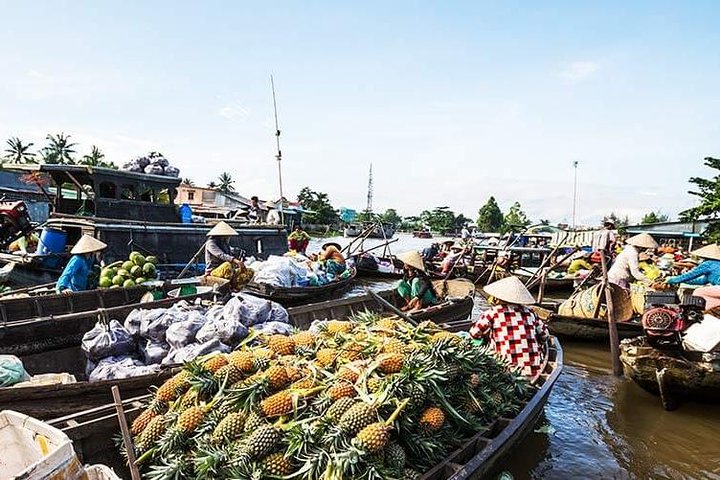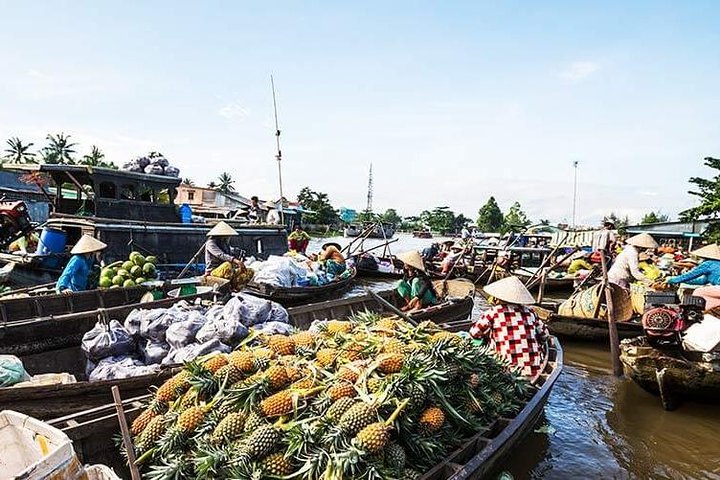Immerse yourself in the rich culture and history of Ho Chi Minh City on this private full-day tour. Visit palaces, temples, and markets, and enjoy a pedicab experience with locals.
Immerse yourself in the rich culture and history of Ho Chi Minh City on this private full-day tour. Visit palaces, temples, and markets, and enjoy a pedicab experience with locals.
- Binh Tay Market - Nestled in Chinatown (Cho Lon), Binh Tay Market is a lively and historic marketplace in Ho Chi Minh City. With origins dating back to the late 19th century, it serves as a bustling center of trade and cultural interaction. Within its vibrant corridors, you can discover a variety of goods including fresh produce, spices, textiles,…
- Binh Tay Market - Nestled in Chinatown (Cho Lon), Binh Tay Market is a lively and historic marketplace in Ho Chi Minh City. With origins dating back to the late 19th century, it serves as a bustling center of trade and cultural interaction. Within its vibrant corridors, you can discover a variety of goods including fresh produce, spices, textiles, handicrafts, and more, all while soaking in the lively ambiance of this iconic market. The market was built by the French colonial administration to replace the older Cho Lon Market, which was destroyed by fire. Binh Tay Market quickly flourished as a key commercial hub, catering to both Chinese merchants and the local Vietnamese community. Over the years, the market has undergone significant changes but was rebuilt and continues to thrive, drawing both locals and tourists. It remains a vital part of the city’s cultural heritage, offering a wide range of products.
- Ba Thien Hau Temple - This stunning 19th-century temple is dedicated to the goddess Thien Hau and attracts a mix of worshippers and visitors who gather beneath the large coils of incense hanging overhead. Thien Hau is believed to travel over the oceans on a mat and ride the clouds to rescue people in distress at sea. The temple features intricate ceramic friezes above the roofline of the interior courtyard, and it is said that two land turtles protect the pagoda. Near the large braziers are two miniature wooden structures where a small figure of Thien Hau is paraded around nearby streets on the 23rd day of the third lunar month. On the main dais are three figures of Thien Hau, each flanked by two servants or guardians. To the right is a scale-model boat, and on the far right is the Goddess Long Mau, Protector of Mothers and Newborns. Visiting this temple offers a glimpse into the local culture of an ethnic minority.
- The Independence Palace - Surrounded by royal palm trees, the striking 1960s architecture of this landmark government building and the eerie atmosphere of its empty halls make it a fascinating sight. The first Communist tanks arrived here on 30 April 1975, and it feels as though time has stood still since then. The building is closely linked to the fall of the city in 1975, but it is the kitschy details and period motifs that stand out. Also known as the Independence Palace, it was home to South Vietnamese president Nguyen Van Thieu until his hurried departure in 1975. Designed by Paris-trained Vietnamese architect Ngo Viet Thu, it is a prime example of 1960s architecture with an airy and open feel. The Reunification Palace, also known as Independence Palace, is a must-see National Monument in the heart of Ho Chi Minh City.
- Khách sạn Bông Sen Sài Gòn - First introduced in Vietnam in 1998, Ganh Bong Sen Buffet offers a perfect blend of traditional Vietnamese dishes and a Western-style buffet. The hand-painted mural features images of popular dishes typically found in provincial town markets, such as banh canh, banh xeo, banh khot, bun rieu, and bun mam. At Ganh Bong Sen Buffet, creative and experienced chefs elevate these traditional dishes into symbols of culinary excellence, offering a taste that is both unique and familiar to connoisseurs of Vietnamese cuisine. It is no surprise that many come to Ganh Bong Sen Buffet to enjoy the distinctive flavors of the three regions. If you want to experience Vietnamese culture and be satisfied, you can count on us. At Ganh Bong Sen Buffet, every meal is a feast for the gods.
- Sơn mài Đại Việt - Lacquer is actually the resin of a tree mixed with colored pigments and solvents, applied layer by layer to an object’s surface to create a shiny and durable finish. Eggshell and mother of pearl may be added to the surface before the lacquer is applied, and the finished product is sanded down to reveal the decoration beneath. The high-quality resin from Vietnamese lacquer trees, especially those in Phu Tho, was crucial to the rapid development of this art form during the feudal period. Decorated lacquer statues, panels, boxes, and trays from 1428-1527 can still be seen in many temples and pagodas. Over the centuries, lacquerware use expanded to larger items like wooden chairs and tables. Today, lacquerware remains a cornerstone of the Vietnamese handicraft industry, both domestically and internationally. Popular items include vases, jewel cases, desk sets, trays, and vertical blinds.
- Central Post Office - This iconic French-era post office, designed by Marie-Alfred Foulhoux (though often attributed to Gustave Eiffel), was built between 1886 and 1891. A mosaic of Ho Chi Minh takes pride of place at the end of its barrel-vaulted hall. The post office features a distinctive bright yellow exterior with white trim. Curved windows are elegantly framed with green shutters, and a large clock is prominently displayed at the main entrance. The stunning interior boasts tall, domed ceilings with metal arches and a beautiful patterned tile floor. Inside, there are two painted maps: “Lignes télégraphiques du Sud Vietnam et du Cambodge 1892” (Telegraphic lines of southern Vietnam and Cambodia 1892) showing the postal route from southern Vietnam to Cambodia, and “Saigon et ses environs, 1892” (Saigon and its surroundings), a local map.
- History Museum of Ho Chi Minh City - Built in 1929, this notable Sino-French museum houses a rich collection of artifacts illustrating the evolution of Vietnamese cultures, from the Bronze Age Dong Son civilization (2000 BCE) and the Funan civilization (1st to 6th centuries CE) to the Cham, Khmer, and Vietnamese cultures. Highlights include valuable relics from Cambodia’s Angkor Wat and a fine collection of Buddha statues, with good English information available. Parts of the museum are being renovated. The museum also features a perfectly preserved mummy of a local woman who died in 1869, excavated from Xom Cai in District 5, and exquisite mother-of-pearl Chinese characters inlaid into panels. Located beside the Botanical Gardens, the museum also showcases the diverse cultures of ethnic groups in Southern Vietnam and other Asian countries, including their clothing, unique musical instruments, statues of deities, and tools related to agriculture, hunting, and fishing.

- All entrance fees
- Air-conditioned vehicle
- Traditional lunch & bottled waters
- English-speaking tour guide
- All entrance fees
- Air-conditioned vehicle
- Traditional lunch & bottled waters
- English-speaking tour guide
- Tips/ gratuities or personal expenses…
- Tips/ gratuities or personal expenses…
Our adventure begins at Binh Tay Market, a bustling hub of activity. From there, we’ll discover the serenity of the Holy Lady Temple, a hidden gem nestled amidst the city’s chaos, offering a peaceful retreat and insight into Vietnamese religious practices. Continuously, we’ll step back in time at the historic Renunification Palace, a symbol of Vietnam’s…
Our adventure begins at Binh Tay Market, a bustling hub of activity. From there, we’ll discover the serenity of the Holy Lady Temple, a hidden gem nestled amidst the city’s chaos, offering a peaceful retreat and insight into Vietnamese religious practices. Continuously, we’ll step back in time at the historic Renunification Palace, a symbol of Vietnam’s tumultuous past and the site of significant historical events. Marveling at the architectural beauty of the Saigon Central Post Office, we’ll admire its elegant French-inspired design before delving into the spiritual realm at the Jade Emperor Pagoda, where intricate sculptures and incense-filled halls create an atmosphere of reverence. A visit to a local Lacquerware factory offers a glimpse into traditional craftsmanship before we delve into the poignant history of the Vietnam War at the War Remnants Museum & Vietnam History Museum, where a vast collection of artifacts and exhibits chronicle the rich tapestry of Vietnam’s past.
- Everyone can join this tour
For a full refund, cancel at least 24 hours before the scheduled departure time.
For a full refund, cancel at least 24 hours before the scheduled departure time.























